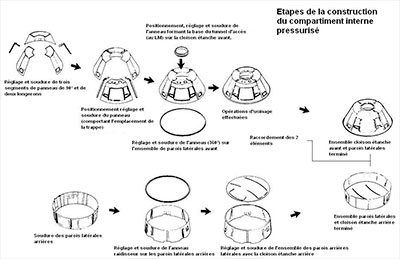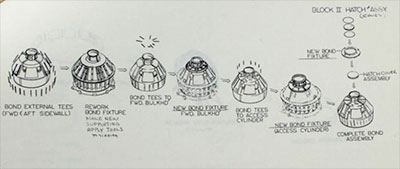|
|

|
|
Author
|
Topic: Apollo Command Module inner structure
|
Apolloman
Member Posts: 171
From: Ledignan, Gard (30), France
Registered: Mar 2009
|
 posted 02-24-2022 09:43 AM
posted 02-24-2022 09:43 AM
   
I open this new discussion because I still have some questions. This time, they are about the Apollo command module inner structure, at least on the information that can be found on the various NASA documents.I would like to know if the dimensions given by Apollo Training, Structures and Mechanical Subsystems Course Number A-512S April 1966 (at the end of the image), are the same for the Block II's inner structure. Can we apply them?  Also, on my website I have this image that I found at the time (about 7 years ago) on a PDF (don't ask me which one, I can't remember):  Just yesterday, I found this one on the internet (an auction ended):  This seems to be the continuation of my image. Does anyone have the complete document in PDF so I can use it to decorate my website? I have the same pictures about the lunar module (I have the whole manufacturing chronology). |
oly
Member Posts: 1378
From: Perth, Western Australia
Registered: Apr 2015
|
 posted 05-16-2022 09:18 PM
posted 05-16-2022 09:18 PM
   
The Block 1 and Block 2 command modules are the same basic structural design, with the Block 2 having the upper hatch included and the unified hatch modification. The dimensions at the bottom of the document you posted are the combined thickness of the inner structural pressure shell and the outer structure (heat shield). The inner structure is of aluminum sandwich construction which consists of a welded aluminum inner skin, adhesively bonded aluminum honey comb core and outer face sheet. The thickness of the honeycomb varies from about 1.5 inches at the base to about 0.25 inch at the forward access tunnel. This inner structure — basically the crew compartment — is the part of the module that is pressurized and contains an atmosphere. The outer structure is the heat shield and is made of stainless steel brazed honeycomb brazed be between steel alloy face sheets. It varies in thickness from 0.5 inch to 2.5 inches. Part of the area between the inner and outer shells is filled with a layer of fibrous insulation as additional heat protection. The Smithsonian has some open-source 3D digitized scans of the interior and exterior of Columbia that you can use to determine the thickness between the exterior and the internal cabin walls if that is the information you are chasing. |
Apolloman
Member Posts: 171
From: Ledignan, Gard (30), France
Registered: Mar 2009
|
 posted 05-19-2022 10:22 AM
posted 05-19-2022 10:22 AM
   
quote:
Originally posted by oly:
The dimensions at the bottom of the document you posted are the combined thickness of the inner structural pressure shell and the outer structure (heat shield).
Are you sure?It is written on the document in question (I quote): ...the thicknesses of the various portions of the inner structure overall wall are as... It is indeed the inner structure and not as you write to me: are the combined thickness of the inner structural pressure shell and the outer structure (heat shield).My question is this: Did the thickness of the inner structure change from Block I to Block II? Thank for your answer. | |
Contact Us | The Source for Space History & Artifacts
Copyright 2022 collectSPACE.com All rights reserved.

Ultimate Bulletin Board 5.47a
|
|

|
 advertisement advertisement

|














